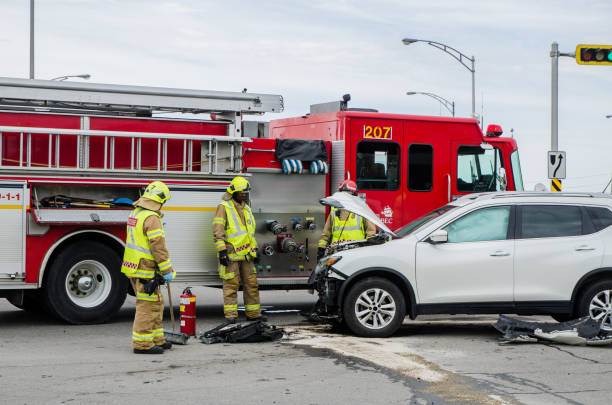If you got involved in a car accident, there are several reasons you might consider suing the other driver, such as:
Negligence
If the other driver failed to exercise reasonable care while driving which resulted in the accident, you may have grounds for a lawsuit. Common reasons include:
- Distracted driving
- Violation of traffic laws
- Driving under the influence
- Inadequate vehicle maintenance
- Fatigued driving
- Not adapting to road or weather conditions

Recklessness
Reckless driving is when the driver showed a willful disregard for other people’s safety on the road. They may have been:
- Over-speeding
- Street-racing
- Driving under the influence
- Aggressive driving
- Ignoring traffic signs and signals
- Road rage
Intentional Misconduct
Road rage, purposeful collision, assault, staged accidents and using the vehicle as a weapon are some of the reasons you can sue the other driver. You’ll need to prove that their actions were deliberate, and that their actions were the cause of your damages and/or injuries or damages.
You can also sue the other party if a loved one was killed because of another person’s negligence, recklessness or misconduct while driving. Other reasons to pursue a claim include suing for pain and suffering, emotional distress, scarring, or disfigurement.
But the question for this post is, “can I sue if I was at fault in a car accident?”
In many cases, determining who’s at fault in a car accident is easy. But sometimes, 2 or more drivers share the responsibility.
Here are a few examples:
- On a busy highway, a speeding car suddenly switches lanes on a dark evening, only to collide with a pickup truck driving without headlights.
- A motorcycle rider maneuvers between two lanes of traffic. Unfortunately, a car changes lanes without signaling and it led to a collision.
- An SUV tries to overtake a slow-moving tractor-trailer in an area marked as a no-passing zone. But the large truck swerves out of its lane which results in a crash with the SUV.

In these situations, is it clear who is at fault? If you were injured, would you be able to claim or sue for damages?
Contributary and Comparative Negligence
Most states follow the comparative negligence systems, which divide fault between the involved parties.
So let’s say Person A negligently makes a left turn and hits Person B. However, Person B was also driving over the speed limit. Person B suffers injuries and sues Person A for $100K, But Person A claims that Person B was over-speeding.
If the case is tried in a comparative negligence state like Arizona, the jury will likely find Person B to be 20% at fault for speeding. So if the damages amount of $100K, then Person B will receive only 80% of this amount, which is $80K as her total damages will need to be reduced for this individual’s 20% share of the fault.
In states following the principle of pure comparative negligence, you’re eligible to receive compensation for your injuries even if you’re partially responsible for the accident.
For instance, if you’re deemed 20% at fault, you can still recover 80% of your total damages. Even if you’re mostly to blame, say 99%, you can still seek compensation for 1% of your damages.
However, there are also states that adopt what’s known as modified comparative negligence system.
In Colorado and Georgia, you can only sue for damages if you’re deemed less than 50% responsible for the accident. For instance, if you’re found to be 45% at fault, you can still recover 55% of your damages. However, if the jury determines you’re 50% or more to blame, you won’t receive any compensation.
Now if the accident took place in a state that follows the principle of Contributory Negligence such as Virginia, Washington D.C. and Alabama, be warned. You may be unable to seek damages if the other party demonstrates that your actions even slightly contributed to the accident.
You read that right. Even if the other driver is 99% responsible and you’re just 1% at fault, you’re unable to recover any damages.
Proving Comparative or Contributory Negligence
Any time you use the roads, you must use reasonable care to ensure your safety and the safety of others. Whether you’re the driver, motorcyclist, passenger, pedestrian or cyclist, if you failed to act how a reasonably careful person should under similar circumstances, you can be found negligent or to share fault for an accident.
But in order to be found at fault (even partially) for a minor car accident, your negligence must have actually contributed to the resulting accident.

So going back to our previous example. If the jury decides that while Person B was indeed speeding, the excessive speed did not actually contribute to the accident that took place. In other words, the accident would have happened even if Person B was not speeding. If this is the case, Person B would be able to recover her total damages of $100K.
Suing the Other Driver in a Comparative Fault State
The Comparative Fault principle states that damage amounts would be reduced proportionally to the extent the person is responsible for the accident. Basically, in states like Virginia, Washington D.C. and Alabama, the jury or the judge will assess each party’s fault which can be anywhere between 1% and 100%.
There are no hard-and-fast rules to determining fault (and to what extent). The percentage is left up to the insurance company (settlement) or jury/judge’s (trial) discretion.
Remember that in settlement negotiations, the other driver’s insurance provider will always look for ways to emphasize your fault so you will be unable to recover all damages so having a lawyer by your side would be to your advantage.

In a Nutshell
It’s not common for one person to be 100% responsible for a car accident. If you hit someone’s vehicle while driving, there’s still some degree of shared fault. Maybe their brake lights aren’t working. Or they were on their phone just before impact.
Moreover, being at fault in a car accident doesn’t always stem from driving errors, distractions, impairment, or health issues. Some occur due to hitting potholes or swerving to avoid obstacles like deer.
But whether or not you can sue if you’re the one at-fault would depend on the laws of your state. If you are in a state that follows the contributory negligence rule, you cannot be awarded any damages if you share any of the blame for the accident.
On the other hand, if your state follows the comparative negligence rule, then yes you can sue the other driver for damages if that driver was also partly responsible.